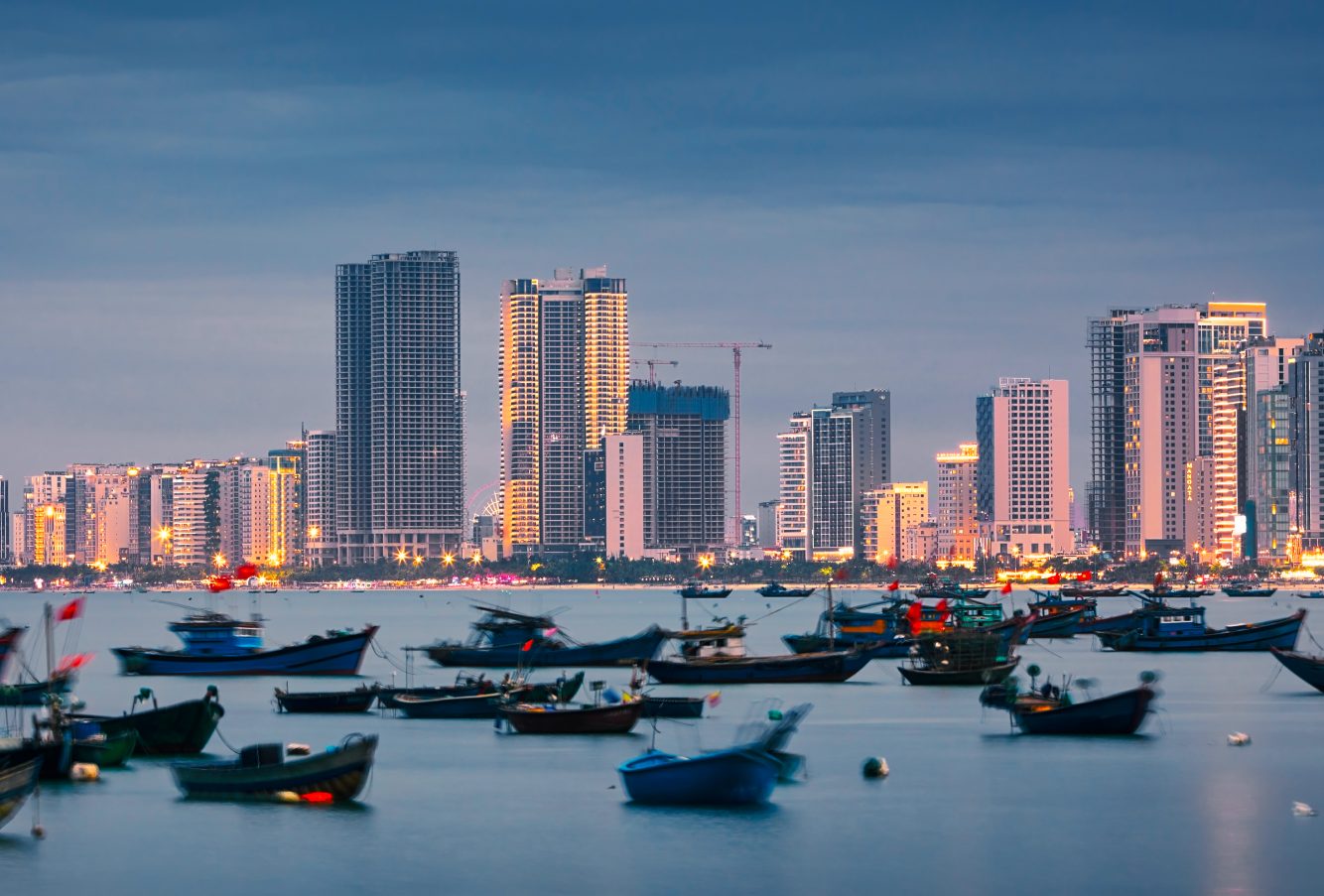Navigating the Logistics Landscape: Shipping from the US to Da Nang Port
Latest update on 18 July, 2024 by Caspian Ng– Marketing Analyst at FreightAmigo
Introduction
The global trade landscape is rapidly evolving, presenting both challenges and opportunities for businesses seeking to expand their reach. One such dynamic market is Vietnam, whose booming economy and strategic location have made it an increasingly attractive destination for exporters worldwide. At the heart of Vietnam’s maritime prowess lies the Port of Da Nang, a thriving gateway poised to facilitate seamless trade connections between the United States and the burgeoning Vietnamese market.
Want To Compare The Best Express, Air Freight, Sea Freight, Rail Freight & Trucking Rates So As To Have Better Control On Cost?
Understanding the Port of Da Nang
Situated along the central coast of Vietnam, the Port of Da Nang is the third-largest port system in the country, strategically positioned at the mouth of the Han River where it meets the South China Sea. This strategic location has made Da Nang a crucial hub for international trade, serving as a vital link between the northern and southern regions of Vietnam. With two main terminals and a dedicated freight warehouse, the port offers a diverse array of cargo handling capabilities, catering to the evolving needs of global shippers.
Geographical Advantages
Nestled in the heart of central Vietnam, the Port of Da Nang enjoys a prime geographical position that enhances its connectivity and accessibility. Its proximity to major economic centers, both within Vietnam and across the region, has made it a preferred choice for businesses seeking efficient and reliable shipping solutions. The port’s direct access to the South China Sea further amplifies its appeal, providing seamless access to global trade routes and facilitating the seamless movement of goods.
Cargo Handling Capabilities
The Port of Da Nang boasts a comprehensive range of cargo handling capabilities, making it a versatile and attractive destination for shippers. From containerized cargo to bulk commodities and specialized freight, the port is equipped to handle a diverse array of goods, ensuring a smooth and efficient logistics experience for its clients. Additionally, the port’s dedicated freight warehouse and advanced cargo handling equipment enable the timely and secure processing of shipments, catering to the evolving needs of the global trade landscape.
Shipping Options from the US to Da Nang
When it comes to shipping from the United States to the Port of Da Nang, businesses have a variety of transportation modes to choose from, each offering its own unique advantages and considerations.
Air Freight
For shippers seeking the fastest mode of transportation, air freight emerges as a viable option. With delivery times as short as 12 hours, air cargo is the preferred choice for time-sensitive, high-value, or perishable shipments. However, this expedited service often comes at a premium, making air freight a more costly alternative compared to other shipping methods.
Ocean Freight
As a more cost-effective option, ocean freight has long been a popular choice for businesses shipping to Vietnam. Both Full Container Load (FCL) and Less-than-Container Load (LCL) services are available, offering flexibility and customization to meet the specific needs of each shipment. While ocean freight typically takes longer, with transit times ranging from 19 to 52 days, it remains a reliable and economical solution for shippers with more flexible timelines.
Intermodal Shipping
For businesses with shipments originating from inland locations within the United States, intermodal shipping can provide a seamless and efficient solution. This approach combines the benefits of both road and rail transportation, with goods being transported by truck to a rail terminal before being loaded onto a vessel for the ocean leg of the journey. Intermodal shipping can offer competitive pricing and reduced environmental impact, making it an attractive option for some shippers.
Factors Influencing Shipping Costs
When planning to ship from the US to the Port of Da Nang, businesses must consider a range of factors that can impact the overall cost of the logistics process. Understanding these variables can help shippers make informed decisions and budget accordingly.
Container Type and Size
The type and size of the container used for the shipment can significantly affect the freight rate. Generally, Full Container Load (FCL) shipments tend to be more cost-effective per unit than Less-than-Container Load (LCL) shipments, as the latter incur additional handling and consolidation fees. Additionally, the choice between a 20-foot or 40-foot container can have a substantial impact on the overall shipping cost.
Cargo Characteristics
The nature of the cargo being shipped, including its weight, dimensions, and value, can also influence the shipping costs. Heavier or larger items may require specialized handling or equipment, leading to higher freight rates. Similarly, high-value goods may be subject to increased insurance premiums, adding to the overall cost of the shipment.
Seasonality and Timing
Shipping rates can fluctuate significantly based on the time of year and the prevailing market conditions. Periods of high demand, such as the lead-up to major holidays or events, often result in increased freight rates as carriers and logistics providers struggle to keep up with the surge in shipment volumes. Careful planning and advance booking can help shippers take advantage of lower rates during off-peak seasons.
Fuel Prices and Surcharges
Fuel prices and associated surcharges can be a significant factor in the overall cost of shipping to Vietnam. As oil prices fluctuate, carriers may adjust their rates accordingly, passing on these changes to their customers. Shippers should be aware of these potential fluctuations and factor them into their budgeting process.
Origin and Destination Ports
The specific origin and destination ports can also impact shipping costs. Proximity to major hubs, infrastructure capabilities, and regional market dynamics can all contribute to variations in freight rates. Shippers should explore multiple port options to identify the most cost-effective route for their shipments.
Navigating Customs and Documentation
Ensuring a smooth customs clearance process is crucial when shipping to Vietnam, as the country’s import regulations can be complex and nuanced. Shippers must be prepared to navigate the necessary documentation and comply with all relevant requirements.
Required Documentation
The key documents required for shipping to Vietnam include a commercial invoice, packing list, bill of lading, certificate of origin, and any necessary permits or licenses for the specific goods being imported. Careful attention to detail and proper preparation of these documents can help expedite the customs clearance process and avoid costly delays.
Customs Duties and Taxes
Vietnam’s tariff schedule is intricate, with most imported goods subject to import duties and value-added taxes (VAT). The exact rates can vary depending on the commodity code and the origin of the shipment. Shippers should familiarize themselves with the applicable tariffs and factor them into their overall shipping costs.
Customs Clearance Procedures
The customs clearance process in Vietnam involves several steps, including the submission of required documentation, payment of applicable fees, and physical inspection of the goods. Engaging the services of a reputable customs broker can greatly streamline this process, ensuring compliance with regulations and minimizing potential delays.
Shipping to Da Nang: Transit Times and Routes
When shipping from the United States to the Port of Da Nang, businesses must consider the transit times and available shipping routes to ensure the timely and reliable delivery of their goods.
Transit Time Estimates
The average transit time for shipping a container from the US to Da Nang can range from 15 to 52 days, depending on the mode of transportation and the specific origin and destination ports. Air freight offers the fastest delivery, with cargo reaching Vietnam in as little as 12 hours, while ocean freight can take between 19 to 52 days, depending on the shipping route.
Top Shipping Routes
The most popular routes for shipping from the US to Da Nang include:
- Los Angeles (USHOU) to Da Nang (VNDAD): 50 days
- Oakland (USOAK) to Da Nang (VNDAD): 15-50 days
- Tampa (USTPA) to Da Nang (VNDAD): 50 days
- Omaha (USOMA) to Da Nang (VNDAD): 21 days
- Seattle (USSEA) to Da Nang (VNDAD): 19 days
Shippers should carefully evaluate these routes, considering factors such as transit time, cost, and reliability, to determine the optimal solution for their specific shipment requirements.
Maximizing Efficiency with Logistics Partnerships
Navigating the complexities of international shipping can be a daunting task for businesses, particularly those new to the Vietnamese market. Leveraging the expertise and resources of a logistics partner can be a game-changer, providing shippers with the support and guidance needed to streamline their operations and achieve their global expansion goals.
Freight Forwarders and Customs Brokers
Partnering with experienced freight forwarders and customs brokers can be invaluable when shipping to Da Nang. These logistics professionals possess in-depth knowledge of the local regulations, customs procedures, and transportation networks, enabling them to guide shippers through the process and ensure a seamless delivery experience. By leveraging their expertise, businesses can minimize the risk of delays, compliance issues, and unexpected costs.
Integrated Technology Solutions
In today’s digital landscape, integrated technology solutions can play a crucial role in enhancing the efficiency and transparency of international shipping. Platforms like FreightAmigo offer shippers the ability to compare freight rates, book shipments, and track their cargo in real-time, all from a centralized online interface. By embracing these innovative tools, businesses can make informed decisions, optimize their logistics operations, and stay ahead of the curve in the ever-evolving global trade environment.
Conclusion
As the Vietnamese economy continues to thrive and the demand for US exports grows, the Port of Da Nang emerges as a strategic gateway for businesses seeking to expand their reach into this dynamic market. By understanding the nuances of shipping to this vibrant port, leveraging the expertise of logistics partners, and embracing innovative technology solutions, shippers can navigate the complexities of international trade with confidence and efficiency.
Whether your business is exploring new opportunities in Vietnam or seeking to optimize your existing supply chain, the insights and strategies outlined in this article can serve as a valuable resource in your journey to conquer new frontiers and unlock the full potential of the global marketplace.
If You’re Looking To Ship From US to Da Nang Port, Please Go To The FreightAmigo Page For Inquiries.
Read more:
Ship from Hong Kong to Vietnam
Shipping From Vietnam to United States
Shipping from Vietnam to Hong Kong
If you have any inquiries on logistics / supply chain, feel free to contact FreightAmigo now:
Chat with us online | Hotline: +852 28121686 | WhatsApp: +852 27467829










































